It is a scimitar-shaped estuary that joins the Bosphorus just at the point where that strait enters the Sea of Marmara, thus forming a peninsula the tip of which is “Old Istanbul” (ancient Byzantion and Constantinople). Its Greek and English names mean the same, but the significance of the designation “golden” is obscure, while its Turkish name Haliç simply means “estuary“. It has witnessed many tumultuous historical incidents, and its dramatic vistas have been the subject of countless works of art.
The Golden Horn is a flooded prehistoric estuary. It is 7.5 kilometers long and is 750 meters across at its widest. Its maximum depth, where it flows into the Bosphorus, is about 35 meters. It is today spanned by four bridges. Moving downstream, the first is the Haliç Bridge, literally Estuary Bridge. The former Galata Bridge was damaged by a fire in 1992; it was moved to the second position in pieces, re-assembled, and restored as the Eski Galata Bridge, literally Old Galata Bridge. The third one is the Atatürk (Unkapanı) Bridge. The current Galata Bridge was completed in 1994. A fifth bridge is currently under construction to connect the subway lines of the Istanbul Metro to the north and south of the Golden Horn.
History
The Golden Horn (Keras) forms a deep natural harbor for the peninsula it encloses together with the Sea of Marmara. The Byzantine Empire had its naval headquarters there, and walls were built along the shoreline to protect the city of Constantinople from naval attacks. At the entrance to the Horn on the northern side, a large chain was pulled across from Constantinople to the old Tower of Galata to prevent unwanted ships from entering. Known among the Byzantines as the Megàlos Pyrgos (meaning “Great Tower” in Greek), this tower was largely destroyed by the Latin Crusaders during the Fourth Crusade in 1204. In 1348 the Genoese built a new tower nearby which they called Christea Turris (Tower of Christ), now called Galata Tower.
There were three notable times when the chain across the Horn was either broken or circumvented. In the 10th century the Kievan Rus’ dragged their longships out of the Bosporus, around Galata, and relaunched them in the Horn; the Byzantines defeated them with Greek fire. In 1204, during the Fourth Crusade, Venetian ships were able to break the chain with a ram. In 1453, Ottoman Sultan Mehmed II, having failed in his attempt to break the chain with brute force, instead used the same tactic as the Rus’, towing his ships across Galata over greased logs and into the estuary.
After the conquest of Constantinople in 1453, Mehmed II resettled ethnic Greeks along the Horn in the Phanar (today’s Fener). Balat continued to be inhabited by Jews, as during the Byzantine age, though many Jews decided to leave following the takeover of the city. This area was repopulated when Bayezid II invited the Jews who were expelled from Spain to resettle in Balat. Today the Golden Horn is settled on both sides, and there are parks along each shore. The Istanbul Chamber of Commerce is also located along the shore, as are Muslim, Jewish and Christian cemeteries. The Galata Bridge connects the neighborhoods of Karaköy (the ancient Galata) and Eminönü.
Until the 1980s the Horn was polluted with industrial waste, but it has since been cleaned. Today its history and beauty make it a popular tourist attraction in Istanbul.
Leonardo’s bridge
In 1502 Leonardo da Vinci produced a drawing of a single-span 240-metre (790 ft) bridge over the Golden Horn as part of a civil engineering project for Sultan Bayezid II. Leonardo’s drawings and notes regarding this bridge are currently displayed at the Museo della Scienza e della Tecnologia in Milan, Italy.
The vision of Leonardo’s Golden Horn Bridge was resurrected in 2001, when a small footbridge based on Leonardo’s design was constructed near Ås in Norway.
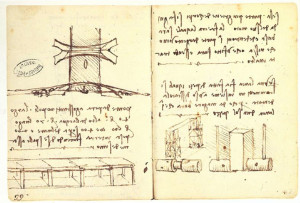
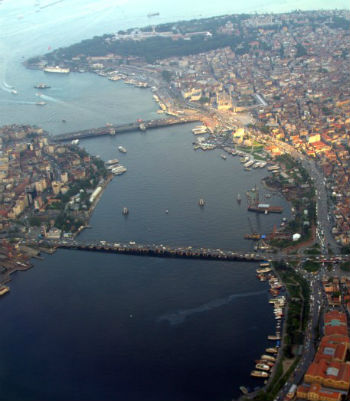
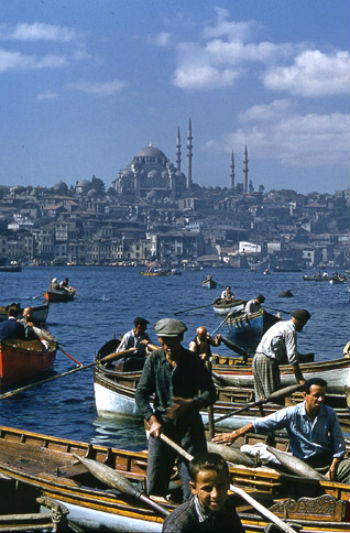
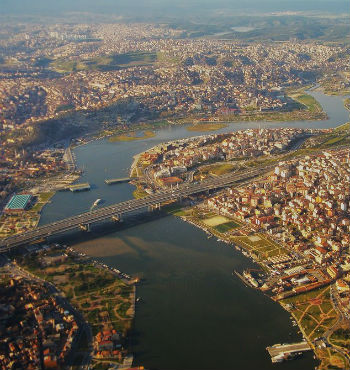
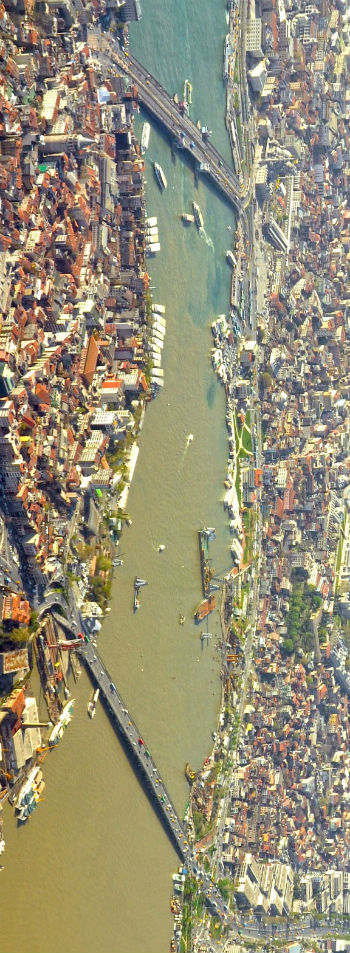


We did a golden horn tour. The ferry ride was nice, good views on the water. Then a cable car ride up the mountain over a huge mountain graveyard. At the top you could see a beautiful panorama view and drink tea or have snack at the cafe. Interesting story of the foreign architect who built a house there.
We saw shipping, mosques, parks, playgrounds, flats, museums, football pitches, factories, theme parks, palaces, shops and the Egyptian Bazaar while driving round the Golden Horn on a tour bus. It's a real cross-section of Istanbul life.
Istanbul is one of the oldest cities in the world and worth visiting. You will find amazing things to do here, regardless of your particular interests, Istanbul has something for you.
Here are general reasons for you:
1. To witness the history of the Byzantine Empire, which was formed when the Roman Empire split up as eastern and western empires in 395,
2. To see the lands which the Byzantine Empire existed on for over one thousand years. To see the capital which has been carried from Roman times to today’s Istanbul,
3. To witness the 600 year long adventure of the Ottoman Empire’s most glorious times, and the founding of the Republic
4. To see the palaces which summarize the 600 year Ottoman adventure, especially the Topkapı Palace and the marvelous buildings, churches, bazaars, fountains, cisterns and streets in the surrounding Sultanahmet area,
5. To witness the magnificent atmosphere of Hagia Sophia, the greatest Christian temple which still stands,
6. To feel the pulse of Europe’s first, and the world’s 5th largest city, with its population of 13.8 million,
7. To become a part of the cultural wealth brought on by the coexistence of the modern and the traditional,
8. To experience going from Europe to Asia in five minutes by boat or by car (during low traffic hours),
9. To watch Asia from Europe, Europe from Asia, and be a part of the “fish by the Bosphorus” tradition while watch
There are more “Reasons to Go”:
√ History of Istanbul is very rich. You can witness the opulent past that remains from the Ottoman Empire and Byzantine Empire periods.
√ Istanbul was Constantinople once. And it was Byzantion before that. The city you will discover will let you see the crown city of three empires.
√ Grand Mosque of Suleymaniye Complex, Spice Market, Saint Sophia, Dolmabahce Palace and Blue Mosque in Istanbul are the places to be seen at least once in a lifetime.
√ Turkish food is very delicious and Turkish cuisine is one of the best cuisines of the world. You will be surprised of the wide range of dishes.
√ Only seeing Bosphorus is a reason itself. (“Bosphorus” is misspelled commonly as: “Bosporus”. The two are the same place.) Shore excursions on Bosphorus are a must-do. And a cruise dinner is a delicious option for a night ride on Bosphorus.
√ Istanbul has boutique s and they are really good. And you will see that there are lots of Istanbul s in Old City and Taksim. There are countless cheap s in Istanbul if you are on a budget too.
√ Shopping in Istanbul is a very funny adventure. You have lots of options like Grand Bazaar and Spice Market for an authentic taste of shopping and lots of shopping facilities, modern shopping malls, picturesque neighborhoods full of stores and little antique shops.
√ And Istanbul life at last, but not least… Nightlife and cultural life is very vibrant and colorful. Istanbulites have their own way of going out and having fun. You will find countless options for any taste.
Practical Reasons to Go”:
√ There are frequent flights to Istanbul from all over Europe, America and Asia. You don’t have to worry about rare flight schedules and you are free to prepare your plans according to your free time.
√ Istanbul is a tourism friendly city. Walking routes of Istanbul city tours are perfect. And you can attend to private Istanbul tours too.
√ The weather in Istanbul is nearly always wonderful. Only the winter months are rainy and cold. If not for anything else, you’ll love Istanbul for the weather.
√ If you have a hobby like photography, this is heaven for you. You will find all kinds of people, interesting streets, amazing light nearly all year, authentic neighborhoods, sea and forests along the shores, vibrant open markets and so on…
And you can;
√ Buy a carpet,
√ Buy an evil-eye talisman.
√ Witness the ceremony of the Whirling Dervises at Galata Mevlevihanesi: The whirling of the sufi mystics and soothing tones of their music will take you to another place,
√ Sweat in a historic Hamam, discover the soothing effects of a Turkish rubdown, relax and leave the worries there,